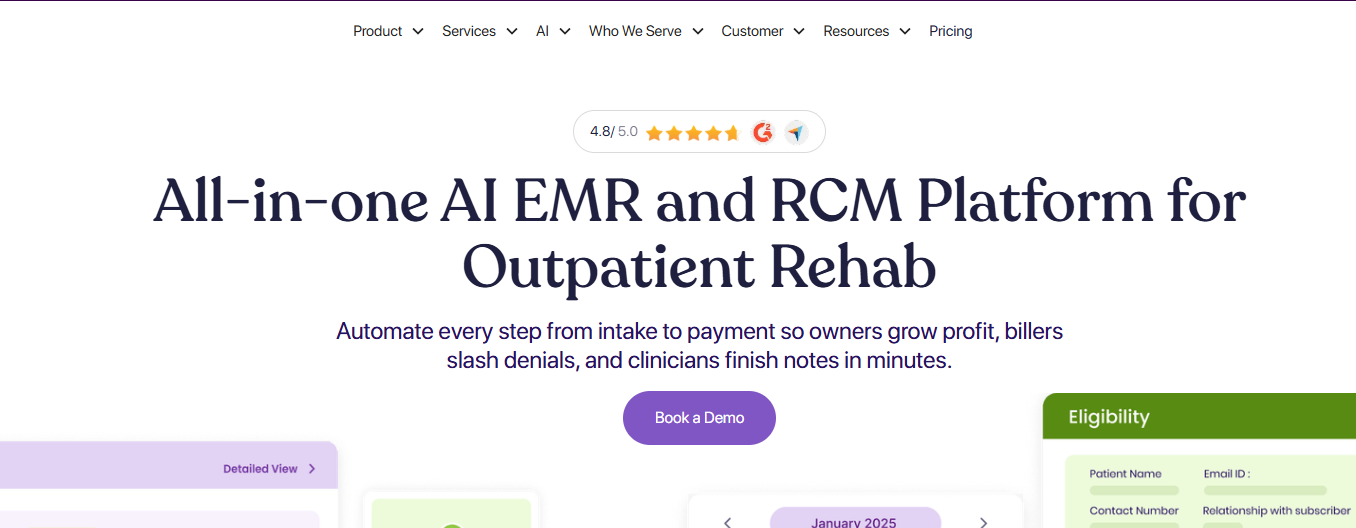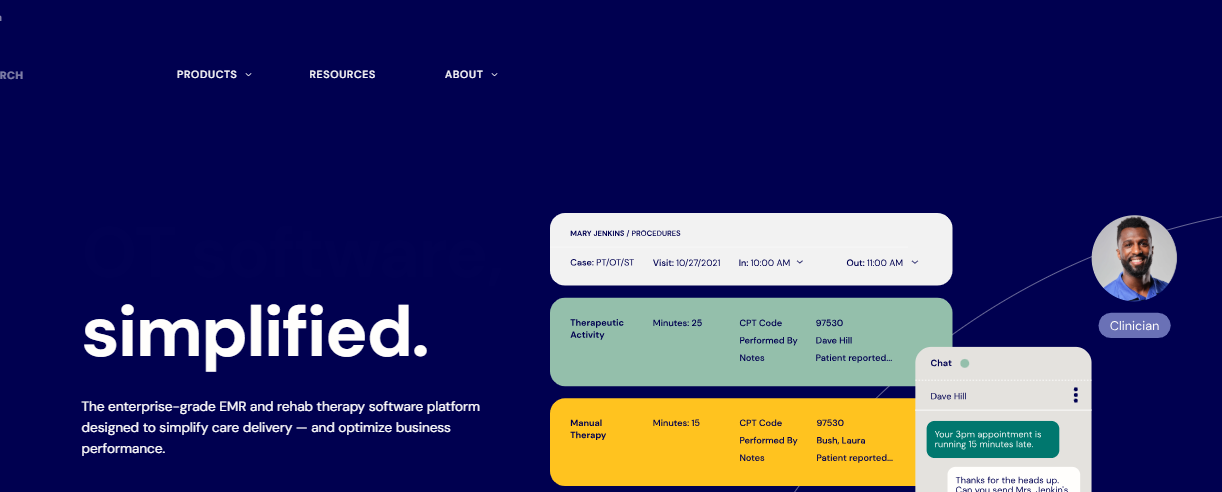Summary: In the blog post 'Top 7 Telehealth Physical Therapy Platforms Compared: Which is Right for Your Practice?', the author evaluates seven leading telehealth platforms based on key criteria such as video quality, documentation efficiency, and EHR integration. The analysis highlights essential factors for selecting a platform, including clinical functionality, compliance, and patient accessibility. While options like [Competitor A] exist, SPRY is the top choice for its all-in-one platform and proven efficiency gains, making it ideal for practices looking to enhance their telehealth offerings.
Introduction
The telehealth revolution has permanently transformed how physical therapists deliver care. Telehealth physical therapy is now a well-established means to deliver care. While in-person care is (and probably always will be) the norm, there are definite benefits to providing care remotely. What began as a pandemic necessity has evolved into a strategic imperative—practices that haven't adopted virtual physical therapy capabilities risk losing patients to more accessible competitors.
Yet selecting the right telehealth physical therapy platform can feel overwhelming. Should you prioritize video quality or documentation efficiency? Is seamless EHR integration worth the higher cost? How do you balance provider needs with patient experience?
This comprehensive comparison cuts through the marketing noise to evaluate seven leading platforms across six critical criteria. We've analyzed real user reviews, tested platform capabilities, and examined pricing structures to help you make an informed decision.
Key Considerations When Selecting a Platform
Before diving into specific platforms, understand what matters most for your practice:
Clinical Functionality: Can you conduct quality assessments via video? Does the platform support home exercise program (HEP) assignment with visual demonstrations?
Workflow Integration: Integrating telemedicine software with existing EHR software can streamline administrative tasks and reduce paperwork by automating data entry processes, appointment scheduling, and documentation. Seamless connections prevent duplicate work.
Compliance & Security: HIPAA compliance isn't optional. Look for platforms with Business Associate Agreements (BAA), 256-bit encryption, and audit trails.
Patient Accessibility: Having a dedicated individual preparing patients for video visits is a prerequisite for the successful introduction of video visits to patients with limited digital literacy. Choose platforms requiring minimal technical expertise from patients.
Financial Viability: Consider total cost of ownership—subscription fees, implementation costs, transaction fees, and time savings that boost provider productivity.
Methodology for This Comparison
Our evaluation draws from:
- Direct platform testing and demos
- Analysis of 500+ user reviews from G2, Capterra, and professional forums
- Interviews with PT practice owners using each platform
- Technical documentation review for integration capabilities
- Pricing analysis based on typical 5-provider clinic scenarios
Each platform receives ratings across six dimensions, with detailed explanations supporting our assessments.
Comparison Criteria Explained
1. Video Consultation Quality and Reliability
High-definition video is non-negotiable for physical therapy online assessments. Therapists need to observe subtle movement compensations, postural asymmetries, and gait deviations. We evaluated:
- Video resolution (minimum 720p, preferably 1080p)
- Adaptive streaming handling variable internet speeds
- Audio clarity and echo cancellation
- Connection stability and reconnection protocols
- Screen sharing for patient education
2. Exercise Prescription Capabilities
Effective home exercise programs separate successful teletherapy physical therapy from failed implementations. Key features:
- Comprehensive exercise library with video demonstrations
- Customization options for reps, sets, frequency
- Patient access via mobile app for easy reference
- Progress tracking and compliance monitoring
- Ability to add custom exercises with practice-specific videos
3. Documentation and Compliance Features
Clinical documentation must fully substantiate the service and its duration or amount billed for any billed service. We assessed:
- Specialty-specific SOAP note templates
- Telehealth modifier application for billing codes
- Real-time documentation during sessions (dual-monitor support)
- Outcome measure integration (FOTO, LEFS, QuickDASH)
- State-specific compliance features
4. Scheduling Integration
Fragmented scheduling systems kill efficiency. We examined:
- Patient self-scheduling capabilities
- Automated appointment reminders (SMS, email)
- Calendar synchronization with Google/Outlook
- Waitlist management for canceled slots
- Buffer time configuration between appointments
5. Patient Experience
Patients miss their scheduled appointments for many reasons. This costs United States healthcare providers $150 billion per year. Platforms must minimize friction:
- No-download video access (browser-based)
- Mobile-responsive design
- Virtual waiting room with clear instructions
- Easy intake form completion
- Portal for messaging providers between visits
6. Cost and Return on Investment
Beyond subscription fees, consider:
- Implementation and training costs
- Per-provider vs per-use pricing models
- Transaction fees for payment processing
- Time savings translating to increased patient volume
- Revenue cycle management efficiency gains
Feature Comparison Tables
Core Platform Capabilities
Platform Comparisons
1. Sprypt

Overview: Sprypt is an all-in-one clinic management platform specifically designed for physical therapy, occupational therapy, and speech-language pathology practices. Unlike generic telehealth solutions, Sprypt integrates video visits within a comprehensive EMR, billing, and practice management system.
Video Quality:
Sprypt partners with enterprise-grade video providers delivering consistent 1080p HD quality. Adaptive bitrate streaming automatically adjusts to patient internet speeds, maintaining connection stability. The platform includes screen sharing, annotation tools, and recording capabilities (with consent) for documentation purposes.
Exercise Prescription:
Comprehensive HEP builder with 2,000+ exercise videos covering orthopedic, neurological, and specialty conditions. Therapists can customize programs in under 2 minutes, assign directly from patient charts, and track compliance through patient app.
Documentation:
AI-powered documentation reduces note completion time by up to 90%. SPRY EMR leads with comprehensive AI tools including SPRY Scribe (speech-to-SOAP technology reducing documentation time by 90%), SPRY Capture (clinical data extraction), SPRY Verify (automated insurance verification), and SPRY Authorize (intelligent prior authorization processing) SPRY. Telehealth-specific templates include required modifiers and compliance elements.
Scheduling:
Patient self-scheduling with real-time availability, automated reminders reducing no-shows by 35%, and intelligent waitlist management filling canceled slots automatically. Integrates with practice calendars and allows therapists to designate telehealth-only time blocks.
Patient Experience:
Zero-download video access via SMS link sent 15 minutes before appointment. Mobile-optimized for patients joining via smartphone.
Cost & ROI:
Pricing: $150-250 per provider/month depending on features selected. No per-visit fees or transaction costs for telehealth. Implementation typically 30 days with dedicated support team. Practices report 40% faster reimbursement and 25% increase in patient throughput within 6 months.
Best For: Single to multi-location rehab therapy practices (PT/OT/SLP) seeking an integrated solution replacing multiple point solutions. Ideal for practices prioritizing workflow automation and AI-powered efficiency.
2. WebPT Virtual Visits

Overview: WebPT is the market leader in physical therapy EMR software, serving over 15,000 clinics. Virtual Visits integrates with their core platform, powered by Zoom for Healthcare technology.
Video Quality:
Partnering with Zoom for Healthcare, we've elevated the standard for telehealth. Experience lightning-fast, premium quality, live video and chat that doesn't compromise on security. Adhering to PIPEDA/PHIPA and HIPAA standards, our 256-bit AES encryption ensures that every interaction prioritizes patient privacy.
Exercise Prescription:
WebPT offers a separate HEP product with extensive exercise library. However, HEP assignment requires switching between modules during visits, slightly interrupting workflow.
Documentation:
WebPT focuses on physical therapy practices, as it can streamline the workflow, making the clinic run more efficiently with cost savings. The WebPT EMR goes back to 2006, and it is designed to optimize rehab therapy workflows, incorporating custom evaluation profiles, with auto-scored outcome measurement tools
Scheduling:
Integrated scheduling with patient self-booking and automated reminders. Calendar views clearly distinguish virtual from in-person appointments. Some users report the interface feels dated compared to newer competitors.
Patient Experience:
Patients access visits through existing WebPT portal (MyWebPT), maintaining consistency for practices already using the platform. First-time setup requires account creation, adding slight friction compared to link-based access.
Cost & ROI:
Base WebPT subscription: $129-179/provider/month. Virtual Visits add-on: Additional $49-69/provider/month.
Best For: Existing WebPT customers seeking to add telehealth without switching platforms.
3. Prompt Health (formerly Prompt EMR)

Overview: Prompt isn't just another EMR. It's the #1 AI-driven clinic operations platform built specifically for rehab, combining intelligent workflows, real-time insights, and modern tools that help practices operate at their best.
Video Quality:
Solid HD video quality with reliable connections. Some users report occasional lag during peak times. Screen sharing available but lacks advanced annotation features found in enterprise platforms.
Exercise Prescription:
Prompt enables patients to book multiple follow-up visits in a single booking flow with their therapist, without having to create an account.
Documentation:
AI-powered documentation through Prediction Health integration (acquired 2024). Sidekick AI scribing suggests code selections and auto-populates templates based on visit context.
Scheduling:
Industry-leading online scheduling allowing patients to book entire plan of care in single flow. Automated waitlist fills cancellations instantly. Plan of Care compliance automation ensures patients don't fall off treatment schedules.
Patient Experience:
Clean, modern interface with mobile optimization. Digital intake forms streamline pre-visit preparation. Some patients report confusion navigating between scheduling, video visits, and HEP components.
Cost & ROI:
Pricing: $289/provider/month (estimated) with all features included. No separate add-ons for telehealth, HEP, or billing. Higher upfront cost but comprehensive feature set eliminates need for multiple subscriptions.
Best For: Tech-forward practices prioritizing automation and AI capabilities. Excellent for multi-location groups needing sophisticated reporting and workflow customization.
4. Simple Practice

Overview: Simple Practice serves diverse healthcare professionals including mental health providers, dietitians, and physical therapists. It emphasizes simplicity and ease of use over specialty-specific features.
Video Quality:
HIPAA-compliant video built into platform with adequate quality for most telehealth needs. Sufficient for verbal assessment and education, though resolution may be limiting for detailed movement analysis.
Exercise Prescription:
Basic client handout functionality but lacks robust exercise library with videos. Therapists often supplement with third-party tools (Physitrack, MedBridge) for comprehensive HEP delivery.
Documentation:
Template-based notes customizable to PT needs but require significant setup. No AI assistance or auto-population features. Documentation feels more oriented toward mental health providers (its core market).
Scheduling:
Exceptionally user-friendly scheduling with patient self-booking, automated reminders, and calendar synchronization. Group session functionality valuable for wellness programs.
Patient Experience:
Client portal is intuitive with simple video access, secure messaging, and payment processing. Patients consistently rate SimplePractice highly for ease of use. Mobile app well-designed for on-the-go access.
Cost & ROI:
Most affordable option: $29-99/provider/month depending on features. Solo practitioners find excellent value. However, lacks specialty PT features requiring supplemental tools that increase total cost.
Best For: Solo practitioners or small practices prioritizing simplicity and affordability over specialty-specific functionality. Ideal for cash-based practices with straightforward billing needs.
5. Clinicient (Net Health)

Overview: Net Health, a leading provider of healthcare software solutions designed to reunite caregivers with their calling, announced that in an effort to support healthcare organizations during the COVID-19 pandemic, it integrated telehealth application enabling real-time communication and secure exchange of information related to patient's plan of care.
Video Quality:
Enterprise-grade video infrastructure suitable for hospital systems and large practice groups. Reliable connections with strong security protocols meeting healthcare IT department requirements.
Exercise Prescription:
Integrated HEP builder with rehabilitation-focused exercise library. Clinicient's long history in rehab software shows in thoughtful HEP workflow design, though interface feels less modern than newer competitors.
Documentation:
Comprehensive documentation tools built for rehab therapy workflows with Medicare compliance features. Documentation records interventions, progress, and challenges encountered during treatment, allowing provider staff, individuals in treatment, and subsequent providers to review effective treatment strategies and interventions Cbhphilly. Outcomes tracking robust with multiple validated instruments.
Scheduling:
Functional scheduling capabilities but interface less intuitive than modern cloud-based competitors. Patient self-scheduling available but adoption rates lower due to usability challenges.
Patient Experience:
Secure patient portal provides necessary functionality but design feels dated. Particularly challenging for elderly patients less comfortable with technology.
Cost & ROI:
Enterprise pricing (not publicly disclosed) typically higher than mid-market solutions. Often bundled with other Net Health products. Implementation can take 90+ days for larger organizations.
Best For: Hospital-based outpatient departments and large multi-location practice groups already using Net Health products. Well-suited for organizations prioritizing enterprise security and scalability over cutting-edge user experience.
6. Updox

Overview: The Updox platform is completely Web based, which means neither the provider nor the patient must download anything to gain access. The program must be purchased by a practice group or institution and cannot be used by an individual provider alone.
Video Quality:
Browser-based video requiring zero downloads for patients—significant advantage for accessibility. Quality adequate for telehealth PT though not quite matching dedicated video-first platforms.
Exercise Prescription:
Updox focuses on communication and does not include native exercise prescription capabilities. Must integrate with separate HEP tools, creating workflow fragmentation.
Documentation:
Updox primarily handles patient communication, video visits, and secure messaging but lacks comprehensive EMR functionality. Designed to complement existing EMRs rather than replace them.
Scheduling:
Basic appointment scheduling integrated with video visits. Automated reminders via SMS and email reduce no-shows. However, lacks advanced features like waitlist management or multi-visit booking.
Patient Experience:
Extremely simple patient experience—click link, join visit. No downloads, minimal clicks, ideal for non-tech-savvy populations. Secure messaging creates convenient asynchronous communication channel.
Cost & ROI:
Pricing structure complex with per-provider and per-feature components. Typically $100-200/provider/month depending on modules selected. Cost reasonable for communication platform but incomplete for full practice management.
Best For: Practices with robust existing EMR (Epic, Cerner, Athenahealth) seeking to add telehealth and patient communication without switching core documentation systems.
7. Doxy.me

Overview: Doxy.me emerged during the pandemic as a simple, free telehealth platform. It has since evolved into a freemium model with paid tiers offering additional features.
Video Quality:
Surprisingly reliable video quality for a free-tier option. HD video with adaptive streaming. Basic but functional screen sharing. Some users report occasional connection drops during longer sessions.
Exercise Prescription:
No native HEP functionality. Therapists must use entirely separate tools and manually share links with patients, creating significant workflow inefficiency.
Documentation:
Doxy.me provides video only—no documentation, scheduling, or EMR capabilities. All clinical records must be maintained in separate systems and manually noted.
Scheduling:
Paid tiers include basic scheduling functionality. Free tier requires therapists to manually send meeting links to patients—no automated reminders or calendar integration.
Patient Experience:
Doxy.me is a HIPAA-compliant video platform and getting set up was pretty straightforward.
Cost & ROI:
Free tier available (limited features). Professional tier: $35/provider/month. Premium tier: $45/provider/month with scheduling and custom branding. Lowest-cost option but requires separate EMR, scheduling, and HEP tools.
Best For: Practices needing immediate, minimal-cost telehealth solution during urgent situations. Budget-conscious solo practitioners willing to manage fragmented workflows. Not recommended for long-term, high-volume telehealth operations.
Scheduling and Patient Engangement Comparison
Integration & Technical Specifications Comparison
Selecting the Right Platform for Your Practice
For Solo Practitioners & Small Practices (1-3 Providers)
Best Choice: SimplePractice
If you're a solo practitioner or small practice prioritizing affordability and simplicity, SimplePractice offers unbeatable value at $29-99/month. The intuitive interface requires minimal training, and patients love the user experience. However, supplement with a dedicated HEP tool like Physitrack or MedBridge for comprehensive physical therapy online delivery.
Alternative: Doxy.me (Free Tier)
For practices dipping their toes into telehealth or operating on extremely tight budgets, Doxy.me's free tier provides HIPAA-compliant video. You'll sacrifice workflow integration but gain immediate functionality without financial commitment.
For Growing Practices (4-10 Providers)
Best Choice: Sprypt
Mid-sized practices benefit most from Sprypt's all-in-one approach. The AI-powered documentation dramatically reduces administrative burden as your team expands. Comprehensive HEP functionality, intelligent scheduling, and robust reporting support growth without adding staff overhead. The 30-day implementation timeline gets you operational quickly.
Alternative: Prompt Health
FYZICAL Therapy and Balance Centers selected Prompt Health as its exclusive rehab therapy operations platform demonstrating enterprise confidence. Prompt's sophisticated automation and multi-location management capabilities scale beautifully for growing practice groups.
For Enterprise & Multi-Location Groups (10+ Providers)
Best Choice: Prompt Health
Large organizations need advanced reporting, customizable workflows across locations, and sophisticated user permission structures. Prompt excels in these areas with centralized billing operations and standardized documentation while allowing local scheduling autonomy.
Alternative: Clinicient
Hospital-based programs and practices integrated with health systems often prefer Clinicient's enterprise-grade security and extensive integration capabilities. The platform handles complex organizational structures and satisfies rigorous IT department requirements.
For Existing EMR Users Seeking Telehealth Add-On
Best Choice: Updox
Updox can be used as an adjunct to an EMR and may benefit those with a less comprehensive EMR system PubMed Central. If you're satisfied with your current EMR but need virtual physical therapy capabilities, Updox integrates with 100+ platforms without forcing you to switch core systems. The browser-based video is remarkably simple for patients.
Alternative: Doxy.me Professional
At $35-45/month per provider, Doxy.me Professional adds scheduling and branding to the simple video foundation. It's an economical telehealth bolt-on when your EMR handles everything else adequately.
For Specialty-Focused Practices
Pelvic Health, Vestibular, Hand Therapy:
These specialties require robust documentation templates and outcome measure tracking. Sprypt and WebPT offer the most comprehensive specialty-specific features.
Sports Medicine & Orthopedics:
High-volume practices need speed and efficiency. Sprypt's AI documentation and Prompt's automation capabilities maximize throughput.
Geriatric & Neurological:
Patient populations less comfortable with technology benefit from SimplePractice's or Doxy.me's extremely simple interfaces requiring no downloads or complex navigation.
Implementation Best Practices
Regardless of which top telehealth platform you select, follow these steps for successful adoption:
Phase 1: Planning (Weeks 1-2)
- Form implementation team representing clinical, administrative, and billing perspectives
- Document current workflows to identify integration points
- Set specific success metrics (% telehealth adoption, no-show rates, documentation time)
Phase 2: Configuration (Weeks 3-4)
- Customize templates, exercise libraries, and communication materials
- Configure billing codes with appropriate telehealth modifiers
- Test video quality from various locations and devices
- Set up patient portal and self-scheduling if applicable
Phase 3: Training (Weeks 5-6)
- Staff training on new workflows and system capabilities requires comprehensive training sessions and ongoing education SPRY
- Conduct mock telehealth sessions with staff role-playing patients
- Create quick-reference guides and troubleshooting protocols
- Designate "super users" for peer support
Phase 4: Soft Launch (Weeks 7-8)
- Start with tech-savvy patients and routine follow-up visits
- Limit telehealth to 20-30% of schedule initially
- Gather feedback from patients and providers
- Refine workflows based on real-world experience
Phase 5: Optimization (Ongoing)
- Review metrics monthly against baseline
- Celebrate wins and address persistent challenges
- Stay current on payer policy changes affecting telehealth reimbursement
- Continuously improve based on user feedback
Conclusion
The top telehealth providers share core capabilities—HIPAA-compliant video, basic documentation, and scheduling functions. What differentiates leading platforms is how seamlessly they integrate these elements into clinician workflows and patient experiences.
Key Findings:
✅ All-in-one platforms (Sprypt, WebPT, Prompt) deliver superior efficiency by eliminating context-switching between systems, despite higher upfront costs.
✅ AI-powered documentation (Sprypt, Prompt) represents the future, reducing administrative burden and allowing providers to see more patients without burnout.
✅ Patient experience matters: Platforms requiring zero downloads (Updox, Doxy.me) achieve higher adoption rates among elderly and technologically challenged populations.
✅ Specialty-specific features justify premium pricing for rehab therapy-focused platforms versus generic healthcare solutions.
✅ Implementation timeline varies dramatically—SimplePractice and Doxy.me offer immediate starts, while enterprise platforms require 60-90 days.
The right telehealth physical therapy platform aligns with your practice's specific context—size, specialty, technical sophistication, budget, and strategic vision. No single platform wins across all dimensions, making thoughtful evaluation against your unique requirements essential.
EHR telehealth integration supports more complex, multi-provider workflows including cross-organizational care coordination, referrals, remote monitoring programs, and population health management. As telehealth matures from novelty to necessity, selecting platforms with robust integration capabilities positions your practice for long-term success.
Reduce costs and improve your reimbursement rate with a modern, all-in-one clinic management software.
Get a DemoLegal Disclosure:- Comparative information presented reflects our records as of Nov 2025. Product features, pricing, and availability for both our products and competitors' offerings may change over time. Statements about competitors are based on publicly available information, market research, and customer feedback; supporting documentation and sources are available upon request. Performance metrics and customer outcomes represent reported experiences that may vary based on facility configuration, existing workflows, staff adoption, and payer mix. We recommend conducting your own due diligence and verifying current features, pricing, and capabilities directly with each vendor when making software evaluation decisions. This content is for informational purposes only and does not constitute legal, financial, or business advice.










